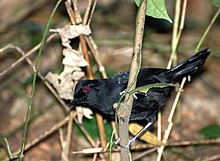Fire-eye
| Fire-eye | |
|---|---|

| |
| White-shouldered fire-eye (Pyriglena leucoptera) | |
| Scientific classification | |
| Domain: | Eukaryota |
| Kingdom: | Animalia |
| Phylum: | Chordata |
| Class: | Aves |
| Order: | Passeriformes |
| Family: | Thamnophilidae |
| Genus: | Pyriglena Cabanis, 1847 |
| Type species | |
| Myiothera domicilla[1] zu Wied, 1831
| |
The fire-eyes, Pyriglena, are a genus of birds in the antbird family Thamnophilidae.The genus contains 5 species, all found in South America. The fire-eyes are 16–18 cm in length, weigh 25-36 g and have characteristic red eyes that give them their name. They have sexually dimorphic plumage, with the females possessing brown to buff coloured bodies with black tails, and the males being black with small patches of white on the back or wings. The fire-eyes eat a variety of insects, and will regularly follow army ants in order to catch prey flushed by them.[2] Two of the fire-eyes are widespread and safe, but one species, the fringe-backed fire-eye, is threatened with extinction.[3]
Taxonomy and systematics
[edit]The genus Pyriglena was introduced by the German ornithologist Jean Cabanis in 1847.[4] The name is from the Ancient Greek word puriglēnos meaning fiery-eyed.[5] The type species is the white-shouldered fire-eye.[6]
The genus contains 5 species:[7]
- Western fire-eye (Pyriglena maura)
- Tapajos fire-eye (Pyriglena similis)
- Fringe-backed fire-eye (Pyriglena atra)
- East Amazonian fire-eye (Pyriglena leuconota)
- White-shouldered fire-eye (Pyriglena leucoptera)
The 5 species of fire-eye have sometimes been treated as a single species.[8] A study published in 2017 recommended that the white-backed fire-eye should be spit into three separate species.[9][10]
References
[edit]- ^ "Thamnophilidae". aviansystematics.org. The Trust for Avian Systematics. Retrieved 2023-07-16.
- ^ Zimmer, K. & M. Isler (2003) "Family Thamnophilidae (Typical Antbirds)" pp.459–531 in del Hoyo, J.; Elliot, A. & Christie D. (editors). (2003). Handbook of the Birds of the World. Volume 8: Broadbills to Tapaculos. Lynx Edicions. ISBN 84-87334-50-4
- ^ BirdLife International (2016). "Pyriglena atra". IUCN Red List of Threatened Species. 2016: e.T22701703A93845126. doi:10.2305/IUCN.UK.2016-3.RLTS.T22701703A93845126.en. Retrieved 17 November 2021.
- ^ Cabanis, Jean (1847). "Ornithologische notizen". Archiv für Naturgeschichte (in German). 13: 186–256 [211].
- ^ Jobling, J. A. (2017). "Key to Scientific Names in Ornithology". Handbook of the Birds of the World Alive. Barcelona: Lynx Edicions. Retrieved 6 May 2017.
- ^ Peters, James Lee, ed. (1951). Check-list of Birds of the World. Vol. 7. Cambridge, Massachusetts: Museum of Comparative Zoology. p. 218.
- ^ Gill, Frank; Donsker, David, eds. (2018). "Antbirds". World Bird List Version 8.1. International Ornithologists' Union. Retrieved 4 February 2018.
- ^ Zimmer, J.T. (1931). "Studies of Peruvian birds. II. Peruvian forms of the genera Microbates, Rhamphocaenus, Sclateria, Pyriglena, Pithys, Drymophila, and Liosceles" (PDF). American Museum Novitates (509): 1–20.
- ^ Isler, M.L.; Maldonado-Coelho, M. (2017). "Calls distinguish species of Antbirds (Aves: Passeriformes: Thamnophilidae) in the genus Pyriglena". Zootaxa. 4291 (2): 275–294. doi:10.11646/zootaxa.4291.2.3.
- ^ Isler, M.; Maldonado-Coelho, M. (October 2017). "Proposal (759): Treat Pyriglena (Thamnophilidae) as consisting of five species". South American Classification Committee of the American Ornithological Society. Retrieved 15 March 2018.

